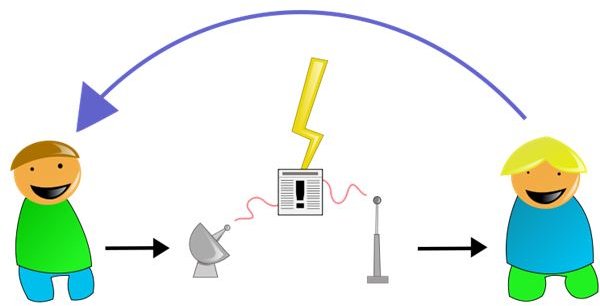Discover the Elements of the Communication Cycle
What Is Communication?
The exchange of information is generally called communication. This exchange can be accomplished in three primary ways:
- Speaking. One person talks to another person or to a group of people in an effort to relay information possessed by the speaker.
- Signaling. A person waving their arms wildly trying to get a car to stop is trying to exchange information about an urgent situation to passersby. Smoke signals, body language, flags, or symbols are just some of the many ways people can send information from one person to others.
- Writing. Whether a shopping list, a novel, or a tax form, writing is a vital part of the communication infrastructure.
Communication failure occurs either when a person transmits information and it is not properly received by its recipients or when important information exists that should be transmitted, but is ignored. For project managers, using a communications management matrix can help by designating who will responsible for transmitting information so that nothing falls through the cracks.
An organized progression is involved with communication as this brief overview of communication already hints. This progression or cycle is important to understand in order to communicate effectively, to identify where barriers to communications are causing problems, and for the project manager to develop an effective communication plan.
Image Credit: Wikimedia Commons/Doodledoo
Transmitting the Message
The first element of the communication cycle involves transmitting information to a recipient, which can be subjective in nature. This process involves the following steps.
Deciding to communicate
Some body language is involuntary, allowing information concerning truthfulness, emotional states, etc., to be transmitted without a person’s consent. Under normal circumstances, no communication can begin without a choice to initiate the transfer of information. This decision, whether appropriate or not, is necessary for the communication cycle to begin.
An example of a conscious nonverbal communication of a different culture is an American Indian sending a smoke signal. Such a person would seem unlikely to build a fire, gather grass and a blanket, and proceed to send a certain number and shape of smoke puffs into the air according to a predetermined code.
Modern communication requires the same type of choice. Sometimes the communication cycle is quashed at the origin because a person is not aware of what circumstances make communication appropriate.
One of the challenges in business is training people with an awareness of how to identify information that is relevant to the group in ways that will foster the success of a project.
Formulating a message
After a person decides to communicate, the message must be formulated. This is where language skills begin playing a significant role in communication. If a person is unable to articulate the message in a coherent way, the information it contains is unlikely to be profitable. For example, information that “the project is doomed” may be good, but additional information about what has gone wrong with the project and how the problem could affect the outcome of the project may be more useful.
Sending the Message
Transmitting the message
A team member may have an important, well articulated message to send, but have difficulty determining the best way to send it. Often, the importance of a message determines its transmission. A message about a minor transportation delay might be sent through an email using appropriate etiquette, but news that the truck carrying vital, rare, and expensive equipment exploded would probably warrant a phone call as well.
Message arrives at the recipient
The first segment of the communication cycle is complete when the information arrives at the recipient. The process is not entirely over because what the recipient does with the information is a significant part of communication.
Feedback
Recipients of information respond in ways that mirror the first part of the cycle. The sender must remain attentive during this phase to evaluate the effectiveness of the transmission.
The decision to send feedback
Most of the time feedback is deliberate. The recipient needs to make a conscious decision to respond to a message received, although technically, failing to provide feedback is also feedback, especially when it can be confirmed that the message was received by the recipient.
Formulating the feedback
When responding to a message, the recipient decides what feedback is appropriate and what words to use in its expression. Ideally, the feedback is composed that addresses the original message. For example, if asked a question, the answer to the question would be fitting. If information was sent, feedback acknowledging its receipt would be helpful.
Feedback that does not seem relevant or logical often can create significant barriers to communication.
Transmitting the feedback
An appropriate medium for sending feedback should be selected. This involves some discernment. Most of the time, replying to a message the same way the message was sent is appropriate. Feedback for a telephone message might be best made via a telephone call while feedback concerning an email might be made via email.
Of course, when communication is unclear, or when feedback becomes urgent, the means of transmission may change.
Feedback is received
The cycle of communication is complete when feedback is received by the original sender. It is the original sender’s responsibility to determine if the feedback is appropriate or if further clarification is necessary. If the feedback is unclear, often the originator must re-initiate the cycle of communication.
Conclusion
Every step in the cycle of communication is essential to virtually any project. Attentiveness to the elements of the communication cycle will help identify when barriers to communication exist, allowing team members to constantly improve the quality of their communication.
